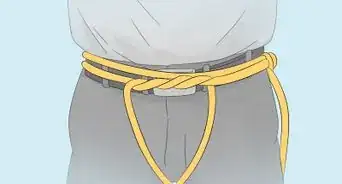This article was co-authored by Steve Bergeron. Steve Bergeron is a Personal Trainer, Strength Coach, and the Co-Owner of AMP Fitness in Boston, Massachusetts. With over a decade of experience, Steve specializes in educating, guiding, and empowering his clients to develop healthy habits and reach their individual fitness goals. He holds a BS in Exercise Physiology and is an NSCA Certified Strength and Conditioning Coach (CSCS), ASCM Health and Fitness Specialist (HFS), Strong First Kettlebell Coach (SFG), and Certified Functional Movement Screen Specialist (FMS). AMP Fitness’ mission is to create a community that is inclusive and gives people the tools and support they need to succeed.
There are 10 references cited in this article, which can be found at the bottom of the page.
This article has been viewed 261,239 times.
Rope-climbing is a great exercise that builds upper-body strength. Before climbing, ensure your rope is anchored securely and your rope-climbing environment is safe. Building your upper body strength before climbing is a good preparation for climbing a rope, and will help make your climbs faster and more efficient. As you improve, you could try a hard technique like an L-sit or a legless climb. No matter what technique you choose, use caution, have fun, and don't try to rush.
Steps
Trying Basic Climbs
-
1Climb with the gym-class technique.[1] To climb a rope with the gym class technique, hold the rope in your hands. Keep your hands close together, with one on top of the other. Pinch the rope between your feet. Remove one hand and place it higher on the rope. Loosen your feet, but keep the rope between them, and bring your knees up to your chest. Pinch the rope again between your feet, and reach up with your other hand. Repeat until you’ve climbed the rope.
-
2Climb a knotted rope. A knotted rope is one with large knots in it at regularly-spaced intervals. To climb the knotted rope, place both hands on the rope in a firm grip. Place your feet to either side of the lowest knot. Proceed with climbing as you would using the gym class method, but use the knots to push off with your legs when climbing. The knots function as small platforms on which you can rest and balance yourself.
- Depending on the intervals between each knot, you might be able to bring your legs up after securing your hands on the rope.
- For instance, with your hands extended as high as possible on the rope and your feet pinching the rope while resting on the knot, lift your feet up to the point where the next knot is. Pinch the rope tightly between your feet, then bring your hands up to a higher position.
- If the knots are spaced further apart, pinch the rope as tightly as possible between your feet and extend your legs. Place your hands as high as possible on the rope. Once you’ve fully extended your arms and legs, bring your legs up as high as you can. Then, pinch the rope tightly between them, then move your hands up along the length of the rope until your feet can rest on the next knot.
- Do not try to grab the knots with your hands.
Advertisement -
3Climb using the brake and squat method.[2] Also called the S-wrap method, this technique is employed by the Marines, and requires trapping the rope between your feet and taking the pressure off your arms. Grab the rope with both hands. You can let the rope fall to one side, or let it dangle between your legs.
- Wrap the rope loosely around one leg. Do not wrap the leg entirely. Rather, let the rope wrap around the back of your calf and beneath the foot of one leg.
- Bring the end of the rope over the top of your other foot.
- Place the heel of the unwrapped foot with the rope on it over the toes of the foot that has the rope beneath it and press down hard. The rope will be trapped between your feet, and your feet will thus function as a kind of clamp to keep the rope stable as you proceed up the rope.
- Reach up with your hands to grab the rope, then loosen the space between your feet and pull up with your arms. Tighten the rope again between your feet as you climb.
- You may need to “reset” the rope between your feet as you climb if it fails to remain in a loose loop over your foot.
Using Advanced Climbing Methods
-
1Climb a rope without your legs.[3] Climbing a rope without your legs is an extremely challenging climbing technique and requires tremendous upper body strength. Grab the rope with both hands. Let your legs dangle loosely below you. Move one hand up on the rope, gripping tightly with the other. Then place the opposite hand above the hand you moved to the high position. Continue in this way, using short, quick movements of the hands and gripping the rope tightly with the other, stabilizing hand until you reach the top.
-
2Climb two ropes at once.[4] Climbing two ropes at once requires two ropes positioned approximately shoulder length apart. This technique also precludes use of the feet.
- Grab one rope in one hand and the other rope in your other hand. Stand between the two ropes with one on each side.
- Grab the rope on your right with your right hand, and the rope on your left with your left hand. Let your feet dangle below you.
- Gripping the left rope tightly, slide your right hand up the length of the rope, then grip it tightly.
- Repeat the process, starting from your right side.
- This technique is also suited for individuals with superior upper body strength.[5]
-
3Try an L-sit climb. An L-sit requires you to start on the ground with your legs straight out in front of you. The goal is to climb the rope while keeping your legs in the same perfectly straight position that they have when you start climbing. With both hands firmly on the rope and your legs out in front of you, place your lower hand above your upper hand in a tight grip. Repeat until reaching the top of the rope, all the while keeping your legs straight out from your body in a horizontal position.
- The position is named the L-sit because viewed in profile, your body should look like an “L.”
Getting the Right Skills and Equipment to Climb
-
1Choose your rope.[6] The ropes used by Navy SEALS are natural fiber Manila ropes. These ropes are prone to fraying over a long period of time but are very strong and generally accepted as the standard in rope climbing. They are readily available online and at some military surplus stores. Your rope should be about twenty feet long and have a two-inch diameter.
-
2Build your upper-body strength. Without a strong upper body, you will be unable to climb with any speed or competence. There are many ways to improve your upper-body strength.[7]
- Pushups are useful for building upper-body strength. To perform a pushup, lay down with your chest against the floor. Place your arms shoulder width apart and place each hand just to the side of its corresponding shoulder. In other words, place your right hand just to the right of your right shoulder and your left hand just to the left of your left shoulder. Point the tips of your toes down and balance on them. Your body should be rigid like a plank. Push off the ground with your arms, then lower yourself until your arms form a ninety degree angle. Repeat 15-30 times, or until you feel significant strain.
- Try pull-ups.[8] Pull-ups require lifting yourself up on a horizontally-oriented metal bar two to three centimeters in diameter. Grab the bar with your hands facing either toward or away from you. Pull your chin up over the bar, then lower yourself back down until your elbows form a ninety degree angle.
- Lift weights. You can lift a barbell on a bench press, or use dumbbells. Start out at a low weight and slowly add weight until you feel a significant strain after 12-15 reps of your given exercise. You could do simple curls, in which you move the hand holding your dumbbell from a ninety degree angle up toward your chest, then back down again for 10-15 reps. Alternately, you could lie on your back on a bench with your arm in a fully extended horizontal position while holding a dumbbell or kettle bell, then bring your arm to a vertical position before returning it to an extended horizontal position.
- Do grip strength exercises.[9] Hang from a pull-up bar with your hands shoulder-width apart. Try to hang on for as long as possible. Do 3 reps and try to increase your hang time by 5-10 seconds with each rep. You can also do wrist curls to strengthen your grip. Get on your knees and rest your elbows on a bench. Hold a barbell so your hands are shoulder-width apart. Then, slowly raise the barbell by curling your wrists up toward you.
-
3Test yourself. If you’re unsure if you’re ready to climb a rope, you can perform a simple test to figure out if you’re ready or not. With your feet still on the ground, reach your hands as high as you can on a rope. Pull your legs up into a tucked position with your knees against your chest and hang on the rope for at least five seconds. Next, extend your right leg as far as possible, then bring it back to a tucked position. Do the same with your left. If you can perform this simple exercise, you’re ready to climb a rope.
-
4Fasten your rope. There are many ways to attach your rope to a fixed object. An eye splice is a strong, safe method of terminating (attaching) a rope to a fixed object.[10] You could use a three-strand eye splice by cutting the ends of the rope into its constituent strands. Mark the rope approximately 15 inches below the end of the rope. Pull each end of the rope over the branch and weave it back into the section of the rope that you marked, turning the rope counterclockwise each time you add weave a strand back into the rope. Repeat at least six times, then trim the ends.
-
5Practice climbing safety. Different ropes can support different amounts of weight, and climbing a rope with a load capacity below your weight could cause it to break.[11] Inspect the rope and its anchor point for wear and tear regularly to ensure it will not break or become detached from its anchor point.
- Always have some spot you as you climb.
- Check the rope’s load capacity before climbing.
- Place landing mats / pads beneath the rope to cushion potential falls.
Expert Q&A
-
QuestionWhat exercises can I do to get better at climbing rope?
 Steve BergeronSteve Bergeron is a Personal Trainer, Strength Coach, and the Co-Owner of AMP Fitness in Boston, Massachusetts. With over a decade of experience, Steve specializes in educating, guiding, and empowering his clients to develop healthy habits and reach their individual fitness goals. He holds a BS in Exercise Physiology and is an NSCA Certified Strength and Conditioning Coach (CSCS), ASCM Health and Fitness Specialist (HFS), Strong First Kettlebell Coach (SFG), and Certified Functional Movement Screen Specialist (FMS). AMP Fitness’ mission is to create a community that is inclusive and gives people the tools and support they need to succeed.
Steve BergeronSteve Bergeron is a Personal Trainer, Strength Coach, and the Co-Owner of AMP Fitness in Boston, Massachusetts. With over a decade of experience, Steve specializes in educating, guiding, and empowering his clients to develop healthy habits and reach their individual fitness goals. He holds a BS in Exercise Physiology and is an NSCA Certified Strength and Conditioning Coach (CSCS), ASCM Health and Fitness Specialist (HFS), Strong First Kettlebell Coach (SFG), and Certified Functional Movement Screen Specialist (FMS). AMP Fitness’ mission is to create a community that is inclusive and gives people the tools and support they need to succeed.
Personal Trainer & Strength Coach I recommend two main things. First, include a lot of pulling exercises like rows and pull-ups in your routine. Second, work on your grip strength and endurance with grip exercises.
I recommend two main things. First, include a lot of pulling exercises like rows and pull-ups in your routine. Second, work on your grip strength and endurance with grip exercises. -
QuestionWhat muscles do you need to climb a rope?
 Michele DolanMichele Dolan is a BCRPA certified Personal Trainer in British Columbia. She has been a personal trainer and fitness instructor since 2002.
Michele DolanMichele Dolan is a BCRPA certified Personal Trainer in British Columbia. She has been a personal trainer and fitness instructor since 2002.
Certified Fitness Trainer You need strong triceps and biceps in the arms plus strong back muscles, specifically the latisumus dorsi and strong abdominals. Strong legs will help too!
You need strong triceps and biceps in the arms plus strong back muscles, specifically the latisumus dorsi and strong abdominals. Strong legs will help too! -
QuestionIs climbing a rope a good workout?
 Michele DolanMichele Dolan is a BCRPA certified Personal Trainer in British Columbia. She has been a personal trainer and fitness instructor since 2002.
Michele DolanMichele Dolan is a BCRPA certified Personal Trainer in British Columbia. She has been a personal trainer and fitness instructor since 2002.
Certified Fitness Trainer Depending on how much time you spend doing this, yes. Climbing rope for 20 minutes is a good cardio workout. Climbing rope even for 5 minutes is good resistance training, building strong muscles.
Depending on how much time you spend doing this, yes. Climbing rope for 20 minutes is a good cardio workout. Climbing rope even for 5 minutes is good resistance training, building strong muscles.
Warnings
- If you feel at all dizzy, descend immediately. You risk falling off the rope and possibly seriously injuring yourself.⧼thumbs_response⧽
- Don't let go and fall off the rope.⧼thumbs_response⧽
- Don't slide down the rope too fast. You don't want rope burn!⧼thumbs_response⧽
References
- ↑ http://www.artofmanliness.com/2012/01/11/how-to-climb-a-rope-like-a-navy-seal/
- ↑ http://www.artofmanliness.com/2012/01/11/how-to-climb-a-rope-like-a-navy-seal/
- ↑ http://www.itstactical.com/fitcom/functional-strength-fitcom/learn-how-to-climb-rope-like-a-navy-seal/
- ↑ http://www.itstactical.com/fitcom/functional-strength-fitcom/learn-how-to-climb-rope-like-a-navy-seal/
- ↑ https://books.google.com/books?id=0FEbq6ip2M8C&pg=PT80&d#v=onepage&q&f=false
- ↑ http://www.artofmanliness.com/2012/01/11/how-to-climb-a-rope-like-a-navy-seal/
- ↑ http://www.mensfitness.com/training/build-muscle/10-upper-body-moves-build-your-core-too
- ↑ Steve Bergeron. Personal Trainer & Strength Coach. Expert Interview. 12 February 2021.
- ↑ Steve Bergeron. Personal Trainer & Strength Coach. Expert Interview. 12 February 2021.
About This Article
To climb a rope, start by grabbing the rope with one hand above the other, and bending your knees so the rope is between your feet. Then, lift one hand above the other before bringing your knees up towards your chest and gripping the rope with your feet. Continue in this manner until you reach the top of the rope. Alternatively, if you’re climbing a knotted rope, place your feet on either side of the rope on the lowest knot, then push off from each knot with your feet. For tips on how to climb a rope without using your legs, keep reading!




































































